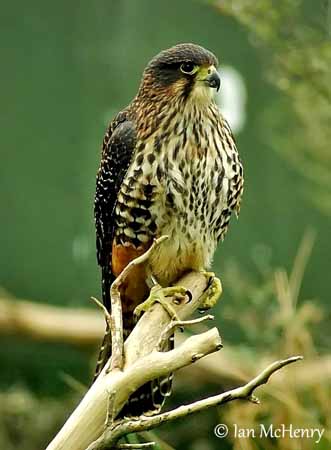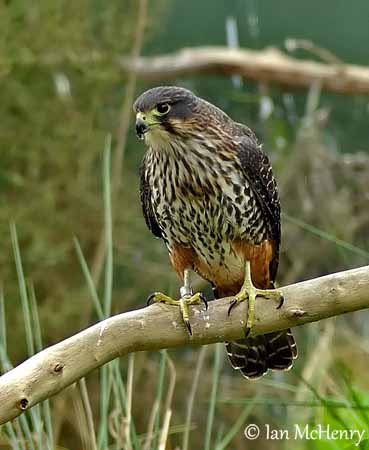
Fr: Faucon de Nouvelle Zélande
Ang: New Zealand Falcon - Bush Hawk, New Zealand Hawk, New Zealand Hobby, Quail Hawk
Maori: Karearea
All: Maorifalke
Esp: Halcón Maorí
Ita: Falco della Nuova Zelanda
Nd: Nieuw-Zeelandse Valk
Sd: Nya Zeelandfalk
Photographer:
Ian McHenry
My New Zealand Birds
Text by Nicole Bouglouan
Sources:
HANDBOOK OF THE BIRDS OF THE WORLD Vol 2 by Josep del Hoyo-Andrew Elliot-Jordi Sargatal - Lynx Edicions - ISBN: 8487334156
KNOW YOUR NEW ZEALAND BIRDS by Lynnette Moon - New Holland Publishers – ISBN: 1869660897
BirdLife International (BirdLife International)
New Zealand birds and birding (Narena Olliver)
Te Ara – The Encyclopedia of New Zealand
WINGSPAN – National Bird of Prey Centre
Information on Observing New Zealand Falcon
New Zealand Falcon
Falco novaeseelandiae
Falconiformes Order – Falconidae Family
INTRODUCTION:
Like numerous Falconidae, the New Zealand Falcon is able to fly at high speeds of up to 200km per hour when hunting. Several live preys are caught on the wing, thanks to the sharp talons.
There are three distinct populations with separate ranges, but there is only one species. The different forms differ in morphology, plumage coloration and habitat.
The Maori name is “Karearea”. This species is endemic to New Zealand.

DESCRIPTION OF THE BIRD:
Biometrics:
Length: 41-48 cm
Wingspan: 66-91 cm
Weight: M: 252-500 g – F: 420-600 g
The adult has dark brown to blackish-brown upperparts, including head, neck, back, wings and tail. This dark plumage is finely barred creamy-white to pale buff.
On the underparts, chin and throat are whitish. Breast, upper flanks and underwing-coverts are whitish to buffy-white, heavily streaked and spotted blackish-brown. Belly, vent, undertail-coverts, lower flanks and thighs are bright rufous, finely streaked brown. Flight feathers and rectrices are similar to above.
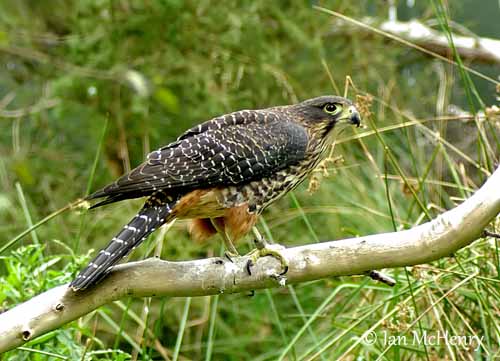
On the head, we can see a broad, black moustachial stripe. The bill is dark bluish-grey. The eyes are brown. Cere, eyering, legs and feet are yellow.
Both sexes have similar plumage but the female is larger and heavier than the male.
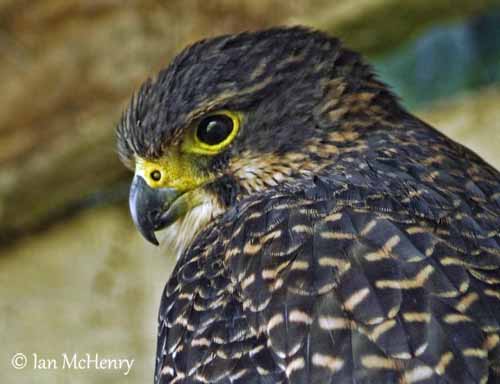
The juvenile has more uniform upperparts. The underparts are darker and less heavily marked than on adults. The bare parts are pale blue to olive-green.
DIFFERENT FORMS AND RANGE:
The New Zealand Falcon occurs in New Zealand, including Stewart Island (but this one is probably extinct), and Auckland Islands.
The three forms from the three distinct populations vary in size and plumage coloration, but also in habitat preference.
The “bush falcon” is the smallest and the darkest. It is found in the forests of the North Island, and W and NW South Island.
The “eastern falcon” is larger with paler plumage. It is mainly found in the open country of the eastern South Island.
The “southern falcon” has more reddish plumage. It is found in coastal areas in Fiordland, Stewart Island and the Auckland Islands.
HABITAT:
The New Zealand Falcon breeds from the coast to above the tree line. It breeds in forest, on cliffs and steep hillsides, far from humans. It is usually found in forests and nearby grasslands, also in mosaic of forest remnants, pine forest, podocarp and beech forests. In may breed in vineyards in the Marlborough region.
This species occurs from sea-level up to 2100 metres of elevation, but it is mainly seen below 1500 metres.
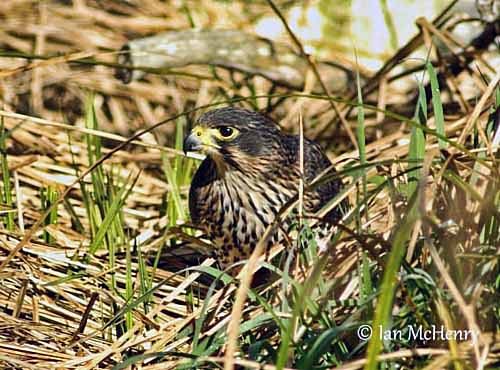
CALLS AND SONGS: SOUNDS BY XENO-CANTO
The New Zealand Falcon utters piercing whistles and screams in flight. The common call is a repetitive “kek-kek-kek” used against intruders in nest defence. A slower “kek…kek…kek…” is given during the aerial displays and used between mates. Females and juveniles “whine” for food.
The male’s call is high-pitched, whereas the female’s voice is deeper.
BEHAVIOUR IN THE WILD:
The New Zealand Falcon is a flesh eater. It takes mainly birds, small and large ones, caught on the wing. Large birds such as pheasants, shags and poultry can be taken. It also catches rabbits and immature hares at speed. Large insects and lizards are part of its diet too.
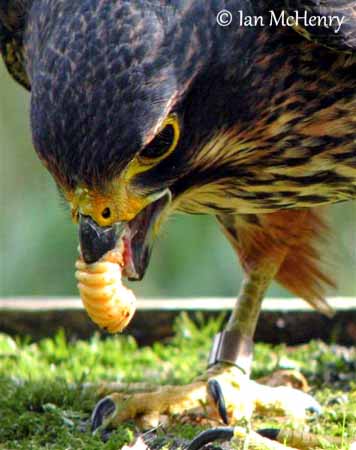
It forages by low, fast flight, or by quartering and high soaring. It often hunts from perch or along the edges of the habitat. It often performs a low contour-flying to surprise and catch a prey.
The New Zealand Falcon is an active hunter with highly manoeuvrable rounded wings and long tail. In the same way, it can follow the preys through dense bush with its long legs.
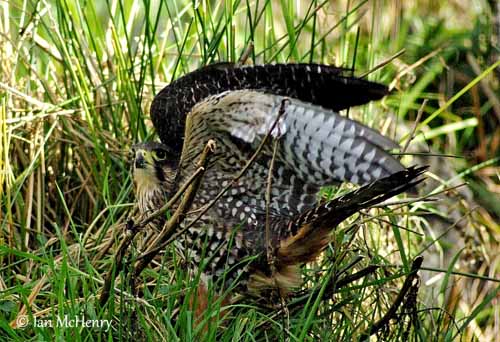
When hunting on the wing, it seizes or strikes the prey, for which stoop or fast and direct attack can be used. It may chase the prey, including among trees. Both mates often hunt together. They may reach speeds of about 200km per hour in high-diving swoops. Then, the prey is brought to a perch when the falcon kills it with the talons, and plucks the feathers before to eat it.
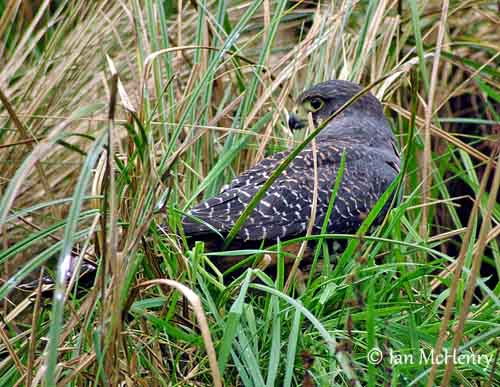
During the breeding season, some spectacular flight actions can be seen between mates, and especially the “pass” when a captured prey is passed in full flight from male to female. Both birds are flying straight towards each other. At the lasts second, both mates roll outwards and touch their talons while the prey is transferred.
This type of behaviour occurs usually during courtship displays and nesting period. But courtship displays start in early spring. The male chases the female and performs false attacks towards her. Then, both sexes perform acrobatic flight. Courtship feeding to female near the future nest-site seals the pair-bond. They are solitary nesters.
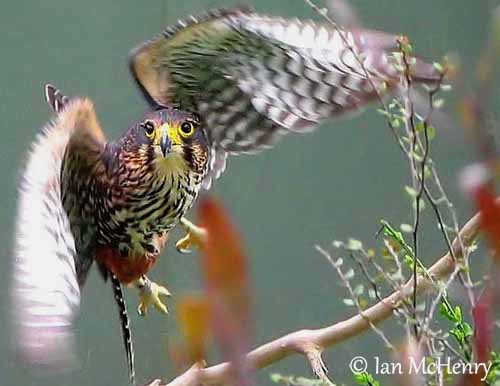
The New Zealand Falcon adult is sedentary. The established pairs remain all year round on their territory. However, the juveniles may move N in winter, and also disperse to lowlands.
The flight is fast and powerful. It can fly through forest or in open areas, and reaches amazing speeds when hunting. It also soars easily.
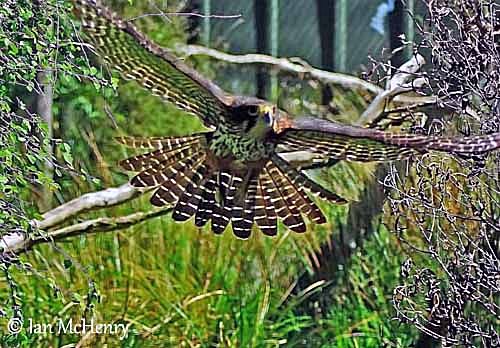
REPRODUCTION OF THIS SPECIES:
The breeding season starts in September/November, sometimes December, and may last until February.
They keep large territories and defend strongly the nest-site against intruders. The New Zealand Falcon nests on high cliff ledges, but also on trees and even on the ground. The nest is a scrape or a shallow depression on a sheltered cliff ledge, or (for the bush falcon), in humus of epiphyte (mainly Astelia) growing on tree. The nest-site is often within 50-100 metres of a stream. The nests placed on the ground are usually protected by overhanging rock, log or vegetation.
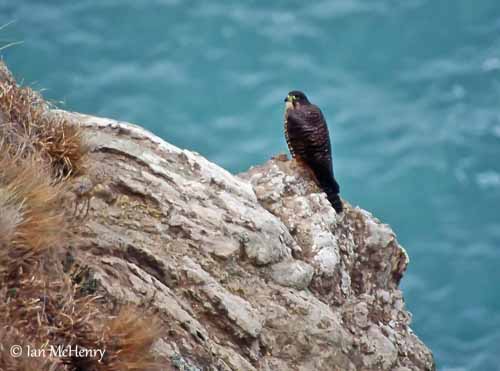
The female lays 2-4 reddish-brown eggs. The incubation lasts 29-35 days, mainly by the female but the male may relieve her for short periods while she is feeding.
At hatching, the chicks have white down, but the second down is grey. They are fed on fresh preys. The adults tear up and feed the chicks with small pieces of flesh. The young fledge 32-35 days after hatching, but they still depend on parents for food for 70-90 days more. However, some fledglings may disperse six weeks after leaving the nest. The juveniles can fly at about 35 days of age.
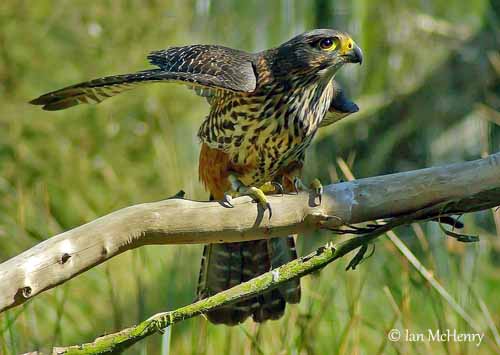
PROTECTION / THREATS / STATUS:
The New Zealand Falcon is threatened by habitat loss. In spite of the large range, the habitat has been reduced by forest clearance. The introduced possum Trichosurus vulpecula is a nest predator and takes the eggs. Cats and mustelids prey on adults and chicks. Persecution still occurs throughout New Zealand and several falcons are killed every year.
In 2010, the population was estimated at about 4,000 pairs, and placed in the band 3,500/15,000 individuals. But it is suspected to be in decline due to habitat destruction, predation by introduced invasive species and human persecution.
The New Zealand Falcon is currently classified as Near Threatened.
